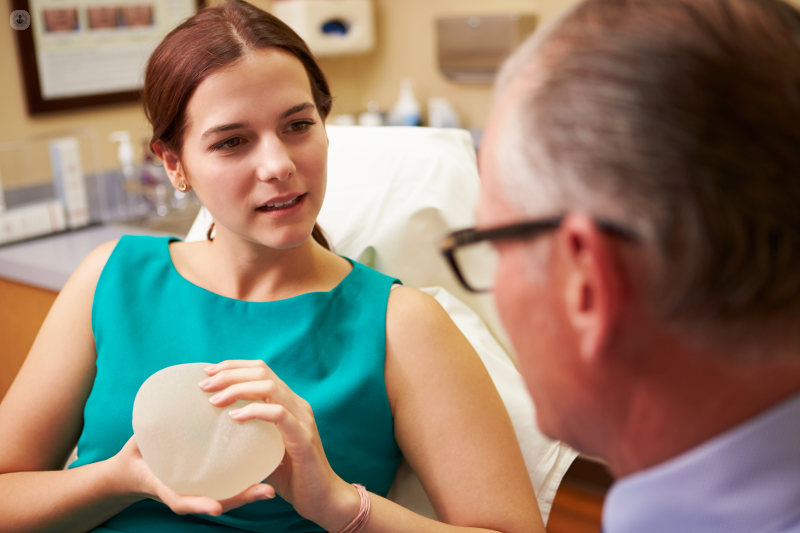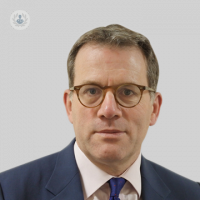Minimising risk in breast augmentation surgery
Escrito por:There is no such thing as risk-free surgery. Even with the safest techniques, patients will occasionally experience problems as a result of their operation, and breast augmentation is no exception. However, there are ways to minimise these risks. Plastic surgeon Mr Ian Grant is here to explain.

What are the risks of breast augmentation surgery?
The risks of breast augmentation surgery can be divided either into major and minor risks, or into early and long-term risks. Major risks may affect the eventual outcome and warrant further surgery, while minor risks are usually dealt with without surgical intervention.
Early risks (in the hours and days after the initial procedure) include:
- Bleeding
- Infection
- Thrombosis
Long-term risks (occurring months or years post-operatively) include:
- Capsular contracture
- Breast implant associated anaplastic large cell lymphoma (BIA-ALCL)
Bleeding
If bleeding occurs shortly after the operation, one of the breasts may quickly swell up. Often, another procedure is urgently required to stop the bleeding and replace the implant. The blood loss means a longer hospital stay and raises the chances of the patient having long-term issues with the implant.
Between 1/50 and 1/200 patients are thought to need reoperation for bleeding. Unfortunately, there is no evidence that administering drugs before or during surgery, or placing a drain reduces the risk; the important thing is an expert surgical technique, with extreme care and attention to detail.
Infection
Infections may occur in the first few weeks after the operation. They can be minor, affecting the skin, or serious, spreading to the implant itself. The implant may even need to be removed to prevent sepsis.
Steps the surgeon can take to reduce the risk of infection:
- Administer antibiotic drugs at the beginning of the procedure.
- Make the incision in the crease below the breast.
- Use an antibiotic/antiseptic rinse before inserting the implants.
- Put an adhesive dressing over the nipple during the operation.
- Put on fresh gloves before picking up the implant.
- Insert the implant using a soft, sterile, plastic funnel.
Patients can help to lower their risks by:
- Not smoking – smokers have a higher risk of infections.
- Keep chronic illnesses such as diabetes or HIV well-controlled with medications.
- Maintain a healthy weight.
Venous thrombosis
Venous thrombosis is a rare complication, occurring in approximately 1/5000 patients, but is potentially very serious. The following factors increase the risk:
- Recent pregnancy
- Obesity
- Being over 40
- Using an oestrogen-based oral contraceptive
Before breast augmentation, each patient will be assessed for potential risk factors. The doctors may take the following measures to reduce the risk of venous thrombosis:
- Compression stockings
- Calf compression during the procedure
- Blood-thinners (injected six hours after surgery in the case of a long operation or an immobile patient)
- Long-acting local anaesthetic – this will give several hours of pain relief, enabling the patient to move around soon after surgery.
Capsular contracture
Some time after breast augmentation, scar tissue may build up around the implant, isolating it in a capsule made by the body. This process, called capsular contracture, can leave a visible deformity in the breast.
Capsular contracture occurs in about one in ten patients ten years after surgery. The likelihood of this problem can be influenced by the type, size, and position of the implants. Patients with implants placed behind the breast (as opposed to partially behind the chest wall muscle), those with smaller and smoother implants, and those with an incision on the edge of the areola rather than the crease under the breast are at a higher risk.
Bacteria can form a “biofilm” around the implant, which can, in turn, lead to the development of a capsular contracture. Steps taken to minimise the risk of an infection at the time of surgery should also help minimise the risk of the formation of a biofilm.
Breast implant associated anaplastic large cell lymphoma (BIA-ALCL)
An extremely rare type of cancer, BIA-ALCL can occur within a capsular contracture around a breast implant. Surgery to remove the implant and capsule is usually curative.
For a woman undergoing cosmetic breast augmentation, the risk of BIA-ALCL is estimated at between 1/4000 and 1/30000. It is not fully understood why the cancer develops; however, almost all patients diagnosed with it had had “macro-textured” implants (rather than smooth implants). The UK national breast implant registry was established in 2016 to record the details of women who have had cosmetic breast augmentation. Over the next ten years, this should tell us whether any one implant carries greater risk. It is hoped that this database will help us to reduce all risks involved with breast augmentation.
Visit Mr Grant’s Top Doctors profile to book an appointment.


